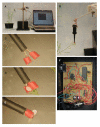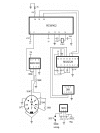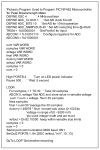A petal breakstrength meter for Arabidopsis abscission studies
- PMID: 16483376
- PMCID: PMC1456958
- DOI: 10.1186/1746-4811-2-2
A petal breakstrength meter for Arabidopsis abscission studies
Abstract
Background: Abscission is the regulated dropping of plant organs, such as leaves or flower petals. This process involves a break down of the cell wall between layers of cells in the abscission zone, causing the organ to become detached. The model plant Arabidopsis thaliana undergoes floral organ abscission. Various experimental methods have been used to study Arabidopsis floral organ abscission, including measuring the petal breakstrength, or the amount of force required to pull a petal from the receptacle. Petal breakstrength provides a quantitative insight into the physical integrity of the petal abscission zone.
Results: We developed a petal breakstrength meter that allows rapid data acquisition on a personal computer. We present the design of the device and show its utility in measuring Arabidopsis petal breakstrength for abscission studies.
Conclusion: This petal breakstrength meter should enable researchers to perform the petal breakstrength assay as a routine part of the characterization of environmental and genetic factors affecting abscission.
Figures





Similar articles
-
Quantitative Analysis of Floral Organ Abscission in Arabidopsis Via a Petal Breakstrength Assay.Methods Mol Biol. 2018;1744:81-88. doi: 10.1007/978-1-4939-7672-0_6. Methods Mol Biol. 2018. PMID: 29392657
-
Love Me Not Meter: A Sensor Device for Detecting Petal Detachment Forces in Arabidopsis thaliana.Methods Mol Biol. 2017;1573:245-252. doi: 10.1007/978-1-4939-6854-1_17. Methods Mol Biol. 2017. PMID: 28293851
-
NEVERSHED and INFLORESCENCE DEFICIENT IN ABSCISSION are differentially required for cell expansion and cell separation during floral organ abscission in Arabidopsis thaliana.J Exp Bot. 2013 Dec;64(17):5345-57. doi: 10.1093/jxb/ert232. Epub 2013 Aug 20. J Exp Bot. 2013. PMID: 23963677
-
Four shades of detachment: regulation of floral organ abscission.Plant Signal Behav. 2014;9(11):e976154. doi: 10.4161/15592324.2014.976154. Plant Signal Behav. 2014. PMID: 25482787 Free PMC article. Review.
-
IDA: a peptide ligand regulating cell separation processes in Arabidopsis.J Exp Bot. 2013 Dec;64(17):5253-61. doi: 10.1093/jxb/ert338. Epub 2013 Oct 22. J Exp Bot. 2013. PMID: 24151306 Review.
Cited by
-
Core Mechanisms Regulating Developmentally Timed and Environmentally Triggered Abscission.Plant Physiol. 2016 Sep;172(1):510-20. doi: 10.1104/pp.16.01004. Epub 2016 Jul 28. Plant Physiol. 2016. PMID: 27468996 Free PMC article.
-
Arabidopsis uses a molecular grounding mechanism and a biophysical circuit breaker to limit floral abscission signaling.Proc Natl Acad Sci U S A. 2024 Oct 29;121(44):e2405806121. doi: 10.1073/pnas.2405806121. Epub 2024 Oct 25. Proc Natl Acad Sci U S A. 2024. PMID: 39453742 Free PMC article.
-
Regulation of floral organ abscission in Arabidopsis thaliana.Proc Natl Acad Sci U S A. 2008 Oct 7;105(40):15629-34. doi: 10.1073/pnas.0805539105. Epub 2008 Sep 22. Proc Natl Acad Sci U S A. 2008. PMID: 18809915 Free PMC article.
-
Leaf shedding as an anti-bacterial defense in Arabidopsis cauline leaves.PLoS Genet. 2017 Dec 18;13(12):e1007132. doi: 10.1371/journal.pgen.1007132. eCollection 2017 Dec. PLoS Genet. 2017. PMID: 29253890 Free PMC article.
-
The tobacco BLADE-ON-PETIOLE2 gene mediates differentiation of the corolla abscission zone by controlling longitudinal cell expansion.Plant Physiol. 2012 Jun;159(2):835-50. doi: 10.1104/pp.112.193482. Epub 2012 Apr 5. Plant Physiol. 2012. PMID: 22492844 Free PMC article.
References
LinkOut - more resources
Full Text Sources

